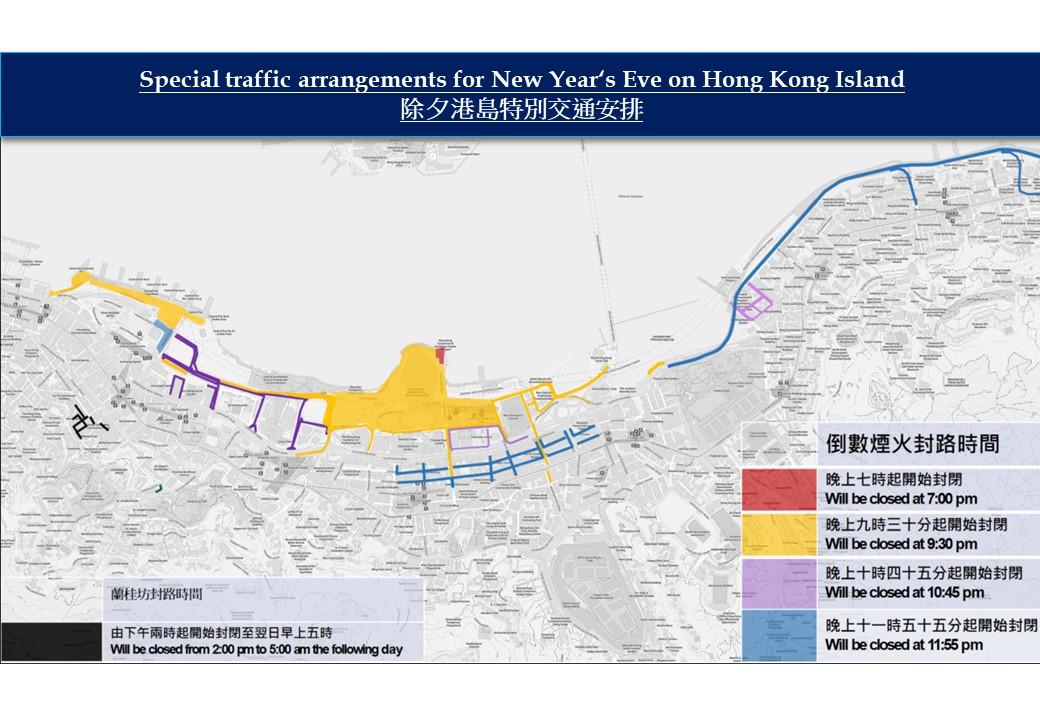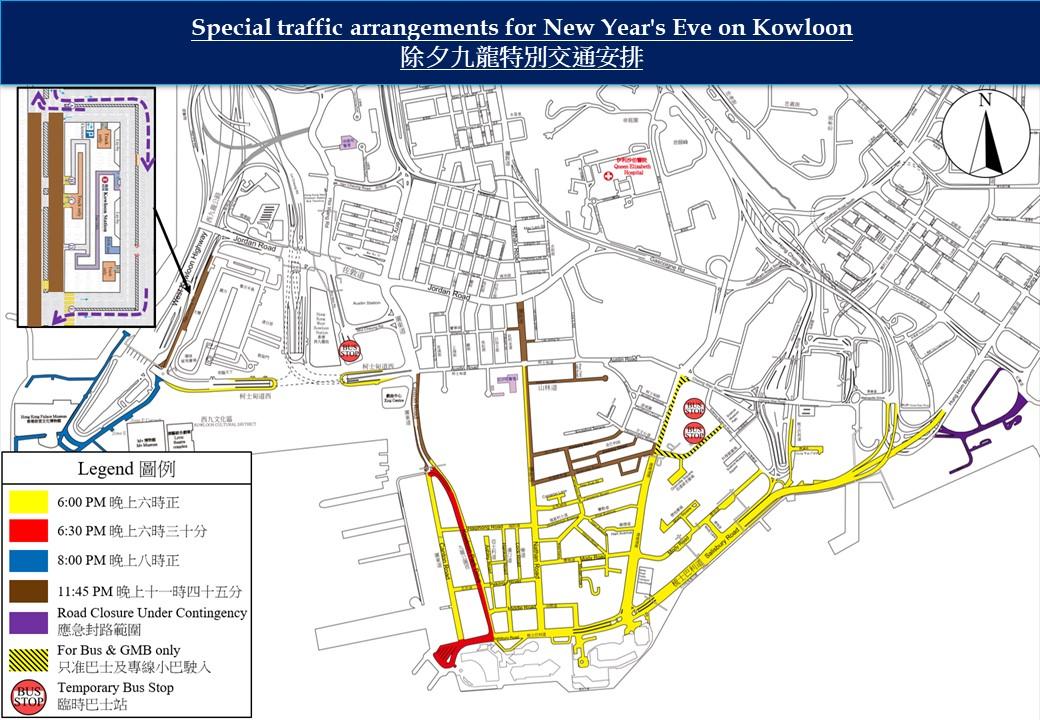The Transport Department (TD) today (December 27) reminded the public that the following special traffic and transport arrangements will be implemented on New Year’s Eve (December 31) to facilitate the fireworks display at Victoria Harbour and related holiday celebration activities.
Road closures
—————
Road closures and the corresponding traffic diversions will be implemented in phases from 2pm that day in road sections in the vicinities of Central District, Wan Chai and Eastern District on Hong Kong Island. The section of Island Eastern Corridor westbound between Victoria Park Road and Man Hong Street will also be temporarily closed to all vehicular traffic (except for franchised buses) from 11.55pm until the reopening of roads.
In Kowloon, road closures and the corresponding traffic diversions will be implemented in phases from about 6pm in the vicinities of Tsim Sha Tsui and the West Kowloon Cultural District until the roads reopen.
During the road closure period, taxi stands (including taxi pick-up/drop-off points), public light bus stands and roadside parking spaces on the roads affected will be suspended.
Public transport service arrangements
——————————————-
(i) In connection with road closures, the bus and green minibus (GMB) routes operating in the affected areas will be temporarily diverted or suspended, and the associated bus and GMB stops located within the affected areas will be suspended or relocated;
(ii) The following MTR service enhancements will be implemented on that day:
- The train frequencies of MTR lines (except Airport Express and Disneyland Resort Lines) will be enhanced from 3pm on December 31, and the services in other periods will be strengthened subject to passenger demand;
- Island Line, Tsuen Wan Line, Kwun Tong Line, Tseung Kwan O Line (sections from North Point to Po Lam and from Tiu Keng Leng to LOHAS Park), South Island Line, Tung Chung Line, East Rail Line (section from Admiralty to Sheung Shui), Tuen Ma Line, and Light Rail route nos. 505, 507, 610, 614P, 615P, 706 and 751 will provide overnight services;
- The last train to Lo Wu will depart from Admiralty at 12.56am while the last train to Admiralty will depart from Lo Wu at 2.30am; and
- The operating hours of Disneyland Resort Line and MTR Bus route nos. 506, K51 and K54 will be extended.
(iii) Fifteen special bus services (including Citybus route nos. 4S, 18R, 38S, N6X and NB3; KMB route nos. N64P, N243, N272 and N276; NLB route no. NB2; and Cross Harbour route nos. 967N, 976S, R11, R11B and R22) will be operated in the small hours on January 1. The service level and operating hours of various bus routes (including one Citybus route, 27 KMB routes, two NLB routes, and five Cross Harbour routes) will be strengthened or extended respectively;
(iv) The operating hours of eight GMB routes on Hong Kong Island, in Kowloon and the New Territories will be extended;
(v) Tram services will be extended to 1.30am the following day and will also be strengthened subject to passenger demand;
(vi) Star Ferry, Sun Ferry, Hong Kong and Kowloon Ferry, Discovery Bay Transportation Services and Park Island Transport will gradually adjust and suspend part of their services from 10.30pm on that night to facilitate the holding of the fireworks display; and
(vii) For the short-haul cross-boundary coach services to Huanggang Port, the following temporary stopping arrangements will be implemented:
- the terminus of the short-haul cross-boundary coach service plying between Wan Chai and Huanggang Port at the Exhibition Centre Station Public Transport Interchange will be suspended from 7pm on December 31 until 7am on the following day. During the period, passengers can use the pick-up point at Hennessy Road westbound near Southorn Centre; and
- a temporary pick-up point for the short-haul cross-boundary coach service plying between Jordan and Huanggang Port will be added at the coach pick-up and drop-off area at Wui Man Road outside Hong Kong West Kowloon Station from 11.30pm on December 31 to 3am on the following day. The operator may extend the service hours of the temporary pick-up point subject to passenger demand. The en-route stop of this service at China Ferry Terminal Bus Terminus will also be suspended from about 8pm until the end of its service that night.
Central to Mid-Levels Escalator and Walkway System Services
———————————————————————
The operating hours of the Central to Mid-Levels Escalator and Walkway System on New Year’s Eve will be extended to 3am on the following day.
Due to extensive road closures, the TD anticipates that the traffic in the vicinities of Hong Kong Island North (including Causeway Bay, Wan Chai, Admiralty, Central and the Island Eastern Corridor), the vicinities of Tsim Sha Tsui and the West Kowloon Cultural District in Kowloon, and the Cross Harbour Tunnel as well as the Aberdeen Tunnel will become significantly congested. Motorists are advised to avoid driving to these areas affected by the road closures. In case of traffic congestion, motorists should exercise patience and drive with care, and follow the instructions of the Police on site.
Members of the public are advised to make use of public transport services as far as possible to avoid traffic congestion and unnecessary delays. The TD and the Police will closely monitor the traffic situation and implement appropriate measures when necessary. Subject to the prevailing crowd and traffic conditions in the areas, the Police may adjust the traffic arrangements. The public should pay attention to the latest traffic news through radio, television or the TD mobile application “HKeMobility”.
For details of the special traffic and public transport arrangements, members of the public may visit the TD website (
www.td.gov.hk) or mobile application “HKeMobility”. Passengers may also refer to the passenger notices displayed by the relevant public transport operators.
read more




